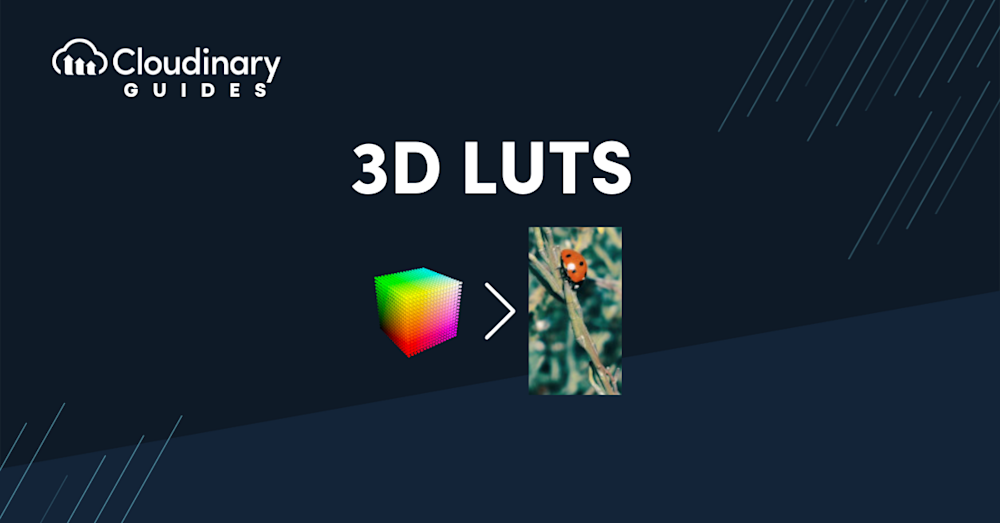3D LUTs (Look-Up Tables) are a transformative element in digital imagery, bridging the gap between raw camera footage and the final visual masterpiece. Unlike simple color adjustments, 3D LUTs comprehensively map out color values to create consistent and cinematic color grading.
They are crucial in achieving a specific aesthetic or mood, ensuring color consistency across different shots, and matching footage from different cameras. This technology is not just for high-end cinema; it’s increasingly used in everything from commercial photography to social media content creation.
In this article, we delve deeper into the technical intricacies and creative applications of 3D LUTs. We’ll explore how they’re revolutionizing color grading workflows, their role in narrative storytelling, why mastering them is essential, and how you can get started using 3D LUTs with Cloudinary.
In this article:
What Are 3D LUTs?
3D LUTs are made up of a 3D grid that maps out output RGB color values, which are determined by input RGB color values. Think of it as a cube where each point changes the color somehow. This cube isn’t just sitting there; it’s an active tool that changes the colors in your image or video.
When the LUT processes a pixel’s color, it corresponds to a particular location within the cube. The values at that location determine the output color, resulting in an adjusted hue that matches the precalculated directive of the LUT. It’s like pinpointing a location on a GPS, but instead of driving towards a physical destination, you’re guiding your colors towards a specific ‘visual destination’.
They come in various resolutions, determining how detailed your color adjustments can be. The usual types are 17grid, 33grid, and 65grid. The bigger the grid number, the more detailed and subtle your color changes can be. It’s like comparing a broad brushstroke to a thin pencil line in drawing – the finer the tool, the more precise the work.
How Are 3D LUTs Used?
One of the primary uses of 3D LUTs is to add color effects to video footage. But it’s not just about tweaking colors or making things brighter or darker; it’s also about creating a certain mood or feeling in the video. Here’s an overview of how they are commonly used:
- Color Grading in Film and Video – One of the primary uses of 3D LUTs is color grading for film and video. They help in achieving a specific look or mood for a scene. For instance, a LUT can give a scene a warm, sunny feel or a cold, blue tone, depending on the intended atmosphere.
- Matching Footage from Different Cameras – In productions where multiple cameras are used, 3D LUTs help match the color profiles of different cameras. This is crucial for maintaining a uniform look throughout the footage, as different cameras might have varying color science.
- Real-time Color Grading – 3D LUTs are used in live broadcasting or real-time video feeds, where they can instantly apply a predetermined look to the footage. This is essential in live sports, news broadcasting, and live-streamed events.
- Photography – Photographers use 3D LUTs in post-processing to quickly apply complex color grades to their images. This is especially useful in batch processing, where a consistent aesthetic needs to be maintained across multiple photos.
- Visual Effects (VFX) – In the VFX industry, 3D LUTs ensure that the colors in the composited elements match the colors in the live-action plates. This helps in creating a seamless blend between the VFX and live footage.
- Device Calibration – LUTs are also used in calibrating monitors and screens, ensuring that the colors displayed are as accurate and consistent as possible.
Creating these 3D LUTs is accessible too. Most color grading software, including popular ones like 3D LUT Creator, Photoshop, and Lightroom, can be used to craft these LUTs. This process is both an art and a science, requiring a keen eye for color and understanding how different hues interact within an image.
The Benefits of Using 3D LUTs
Using LUTs brings a ton of benefits and advantages, helping bridge the gap between precision and creative flexibility in color processing. 3D LUTs help keep your color grading consistent. Whether you’re working on one project or several, they ensure the colors stay the same across different shots and scenes. This consistency is essential, especially if you’re trying to keep a particular mood or style throughout your work.
Speed and efficiency are other significant benefits of using 3D LUTs. You can apply complex color grades with just a few clicks, saving hours that would otherwise be spent manually tweaking color settings. This efficiency is a lifesaver, especially when working under tight deadlines or handling large volumes of footage.
Then there’s the aspect of creativity. 3D LUTs offer a high level of creative control, enabling artists and creators to achieve specific visual styles. LUTs provide filmmakers and photographers with a powerful tool to attain distinct visual styles and moods, enhancing the storytelling aspect of the visual content. The possibilities are almost limitless, from emulating film stock to creating unique color tones.
Lastly, 3D LUTs enhance the overall quality of your images and videos. They help in achieving a more professional, polished look, which is essential whether you’re creating content for personal projects or professional clients.
Using 3D LUTs with Cloudinary
Cloudinary, with its robust cloud-based image and video management services, offers smooth integration with 3D LUTs. This integration means you can apply your custom or pre-defined LUTs directly to your pictures and videos stored in Cloudinary. It’s like having a powerful color grading studio at your fingertips, accessible anywhere, anytime.
One of the standout features of using Cloudinary is the ease of automation. Imagine you have a series of images or videos that need a consistent color grade. Instead of applying the LUT to each item individually, Cloudinary allows you to automate this process, applying your chosen LUT across all your media with minimal effort. This automation saves time and ensures uniformity across your entire media library.
Another benefit of this integration is the flexibility it offers. With Cloudinary, you’re not limited to a set number of LUTs or styles. You can upload and apply any 3D LUT you’ve created or acquired, giving you complete creative control over your color grading process. This flexibility is invaluable, especially when looking to stand out or achieve a specific visual signature.
Closing Thoughts
Looking back, learning about 3D LUTs is like unlocking a secret color language. These tools let you precisely control your work’s emotions, tones, and stories. 3D LUTs offer the ability to efficiently transform and enhance visual content, providing consistency, creative control, and a high degree of flexibility in color grading. They are an indispensable tool in the digital imaging industry, aiding professionals and amateurs alike in achieving their desired visual outcomes.
The mix of 3D LUTs with Cloudinary stands out. It merges advanced color editing with Cloudinary’s efficient, scalable cloud tech. This combo makes your workflow smoother, saves time, and helps you fully realize your creative ideas. As you go on with your creative projects, remember that 3D LUTs are more than just for color editing. They unlock the full potential of your images and videos. And Cloudinary is there to ensure you can always use this power to its fullest.


